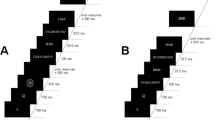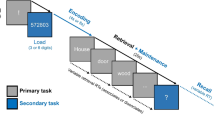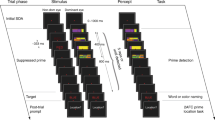Abstract
Recent studies using an induction task paradigm indicated that unconscious automatic processes underlying masked semantic priming are susceptible to cognitive control influences. In this paradigm, participants first perform different induction tasks (semantic decision vs. perceptual decision), which serve to activate a corresponding task set. Thereafter, the masked prime and the target for the lexical decision task is presented. Previously, perceptual and semantic induction tasks were presented in separate blocks, and the response to the induction task was given immediately after the inducing stimulus. The present study, therefore, tested two possible boundary conditions, flexibility of cognitive control and completeness of task set execution, for the emergence of task set effects on masked semantic priming. In the first experiment, perceptual and semantic induction tasks were presented in a randomized fashion, to assess whether task set influences on masked semantic priming can occur on a trial-by-trial basis. The other two experiments tested whether task set effects on masked priming survive, when the response to the induction task is delayed. The present study yielded the same pattern of results irrespective of the variations in the induction task paradigm: When the masked prime was shortly presented after the induction task, masked semantic priming was larger subsequent to the semantic than subsequent to the perceptual induction task. The present study shows that task sets can configure unconscious processing streams rapidly on a trial-by-trial basis and demonstrates the generalizability of cognitive control effects on masked semantic priming across variations of the induction task paradigm.




Similar content being viewed by others
References
Adams, S. C., & Kiefer, M. (2012). Testing the attentional boundary conditions of subliminal semantic priming: The influence of semantic and phonological task sets. Frontiers in Human Neuroscience, 6, 241. https://doi.org/10.3389/fnhum.2012.00241.
Ansorge, U., Fuchs, I., Khalid, S., & Kunde, W. (2011). No conflict control in the absence of awareness. Psychological Research Psychologische Forschung, 75, 351–365.
Ansorge, U., Kiefer, M., Khalid, S., Grassl, S., & König, P. (2010). Testing the theory of embodied cognition with subliminal words. Cognition, 116(3), 303–320.
Ansorge, U., Kunde, W., & Kiefer, M. (2014). Unconscious vision and executive control: How unconscious processing and conscious action control interact. Consciousness and Cognition, 27C, 268–287.
Ansorge, U., & Neumann, O. (2005). Intentions determine the effect of invisible metacontrast-masked primes: Evidence for top-down contingencies in a peripheral cueing task. Journal of Experimental Psychology: Human Perception and Performance, 31(4), 762–777.
Bermeitinger, C., Wentura, D., & Frings, C. (2011). How to switch on and switch off semantic priming effects for natural and artifactual categories: Activation processes in category memory depend on focusing specific feature dimensions. Psychonomic Bulletin & Review, 18(3), 579–585. https://doi.org/10.3758/s13423-011-0067-z.
Cumming, G. (2014). The new statistics: Why and how. Psychological Science, 25(1), 7–29. https://doi.org/10.1177/0956797613504966.
Deacon, D., Hewitt, S., Chien-Ming, Y., & Nagata, M. (2000). Event-related potential indices of semantic priming using masked and unmasked words: Evidence that the N400 does not reflect a post-lexical process. Cognitive Brain Research, 9(2), 137–146.
Desender, K., Van Opstal, F., & Van den Bussche, E. (2014). Feeling the conflict: The crucial role of conflict experience in adaptation. Psychological Science, 25(3), 675–683. https://doi.org/10.1177/0956797613511468.
Faul, F., Erdfelder, E., Lang, A. G., & Buchner, A. (2007). G*Power 3: A flexible statistical power analysis program for the social, behavioral, and biomedical sciences. Behavior Research Methods, 39(2), 175–191. https://doi.org/10.3758/Bf03193146.
Gratton, G., Coles, M. G. H., & Donchin, E. (1992). Optimizing the use of information: Strategic control of activation of responses. Journal of Experimental Psychology: General, 121(4), 480–506. https://doi.org/10.1037//0096-3445.121.4.480.
Green, D. M., & Swets, J. A. (1966). Signal detection theory and psychophysics. New York: Wiley.
Houghton, G., Pritchard, R., & Grange, J. A. (2009). The role of cue-target translation in backward inhibition of attentional set. Journal of Experimental Psychology: Learning, Memory, and Cognition, 35(2), 466–476.
Jost, K., Hennecke, V., & Koch, I. (2017). Task dominance determines backward inhibition in task switching. Frontiers in Psychology, 8, 755. https://doi.org/10.3389/fpsyg.2017.00755
Kentridge, R. W., Heywood, C. A., & Weiskrantz, L. (2004). Spatial attention speeds discrimination without awareness in blindsight. Neuropsychologia, 42(6), 831–835.
Kiefer, M. (2002). The N400 is modulated by unconsciously perceived masked words: Further evidence for an automatic spreading activation account of N400 priming effects. Cognitive Brain Research, 13(1), 27–39.
Kiefer, M. (2012). Executive control over unconscious cognition: Attentional sensitization of unconscious information processing. Frontiers in Human Neuroscience, 6, 61, https://doi.org/10.3389/fnhum.2012.00061.
Kiefer, M., Adams, S. C., & Zovko, M. (2012). Attentional sensitization of unconscious visual processing: Top-down influences on masked priming. Advances in Cognitive Psychology, 8(1), 50–61.
Kiefer, M., Liegel, N., Zovko, M., & Wentura, D. (2017). Mechanisms of masked evaluative priming: Task sets modulate behavioral and electrophysiological priming for picture and words differentially. Social Cognitive and Affective Neuroscience, 12(4), 596–608. https://doi.org/10.1093/scan/nsw167.
Kiefer, M., & Martens, U. (2010). Attentional sensitization of unconscious cognition: Task sets modulate subsequent masked semantic priming. Journal of Experimental Psychology: General, 139(3), 464–489.
Kiefer, M., Sim, E. J., & Wentura, D. (2015). Boundary conditions for the influence of unfamiliar non-target primes in unconscious evaluative priming: The moderating role of attentional task sets. Consciousness and Cognition, 35, 342–356. https://doi.org/10.1016/j.concog.2015.01.010.
Kiefer, M., & Spitzer, M. (2000). Time course of conscious and unconscious semantic brain activation. NeuroReport, 11(11), 2401–2407.
Kiesel, A., Kunde, W., & Hoffmann, J. (2007). Mechanisms of subliminal response priming. Advances in Cognitive Psychology, 3(1–2), 307–315.
Kiesel, A., Steinhauser, M., Wendt, M., Falkenstein, M., Jost, K., Philipp, A. M., et al. (2010). Control and inference in task switching—A review. Psychological Bulletin, 136(5), 849–874.
Koch, I. (2005). Sequential task predictability in task switching. Psychonomic Bulletin & Review, 12(1), 107–112. doi:https://doi.org/10.3758/Bf03196354.
Koch, I. (2008). Instruction effects in task switching. Psychonomic Bulletin & Review, 15(2), 448–452. https://doi.org/10.3758/Pbr.15.2.448.
Kunde, W. (2003). Sequential modulations of stimulus-response correspondence effects depend on awareness of response conflict. Psychonomic Bulletin & Review, 10(1), 198–205. https://doi.org/10.3758/Bf03196485.
Kunde, W., Kiesel, A., & Hoffmann, J. (2003). Conscious control over the content of unconscious cognition. Cognition, 88(2), 223–242.
Martens, U., Ansorge, U., & Kiefer, M. (2011). Controlling the unconscious: Attentional task sets modulate subliminal semantic and visuo-motor processes differentially. Psychological Science, 22(2), 282–291.
Martens, U., & Kiefer, M. (2009). Specifying attentional top-down influences on subsequent unconscious semantic processing. Advances in Cognitive Psychology, 5, 56–68.
Mayr, U., & Keele, S. W. (2000). Changing internal constraints on action: The role of backward inhibition. Journal of Experimental Psychology: General, 129(1), 4–26.
Monsell, S. (2003). Task switching. Trends in Cognitive Sciences, 7(3), 134–140.
Monsell, S., Sumner, P., & Waters, H. (2003). Task-set reconfiguration with predictable and unpredictable task switches. Memory & Cognition, 31(3), 327–342. https://doi.org/10.3758/Bf03194391.
Moors, A., & De Houwer, J. (2006). Automaticity: A theoretical and conceptual analysis. Psychological Bulletin, 132(2), 297–326.
Naccache, L., Blandin, E., & Dehaene, S. (2002). Unconscious masked priming depends on temporal attention. Psychological Science, 13(5), 416–424. https://doi.org/10.1111/1467-9280.00474.
Neumann, O. (1984). Automatic processing: A review of recent findings and a plea for an old theory. In W. Prinz & A. F. Sanders (Eds.), Cognition and motor processes (pp. 245–293). Berlin: Springer.
Neumann, O. (1990). Direct parameter specification and the concept of perception. Psychological Research Psychologische Forschung, 52(2–3), 207–215.
Oldfield, R. (1971). The assessment and analysis of handedness: The Edinburgh Inventory. Neuropsychologia, 9(1), 97–113. https://doi.org/10.1016/0028-3932(71)90067-4.
Ortells, J. J., Kiefer, M., Castillo, A., Megias, M., & Morillas, A. (2016). The semantic origin of unconscious priming: Behavioral and event-related potential evidence during category congruency priming from strongly and weakly related masked words. Cognition, 146, 143–157. https://doi.org/10.1016/j.cognition.2015.09.012.
Posner, M. I., & Snyder, C. R. R. (1975). Attention and cognitive control. In R. L. Solso (Ed.), Information processing and cognition: The Loyola Symposium (pp. 55–85). Hillsdale: Lawrence Erlbaum Associates.
R-Core-Team (2017). R: A language and environment for statistical computing. Vienna: R Foundation for Statistical Computing.
Rogers, R. D., & Monsell, S. (1995). Costs of a predictable switch between simple cognitive tasks. Journal of Experimental Psychology: General, 124(2), 207–231.
Rouder, J. N., Morey, R. D., Speckman, P. L., & Province, J. M. (2012). Default Bayes factors for ANOVA designs. Journal of Mathematical Psychology, 56(5), 356–374. https://doi.org/10.1016/j.jmp.2012.08.001.
Ruoff, A. (1990). Häufigkeitswörterbuch gesprochener Sprache (2nd edn.). Tübingen: Niemeyer.
Schneider, W., & Shiffrin, R. M. (1977). Controlled and automatic human information processing: 1. Detection, search, and attention. Psychological Review, 84(1), 1–66. https://doi.org/10.1037/0033-295X.84.1.1.
Spruyt, A., De Houwer, J., Everaert, T., & Hermans, D. (2012). Unconscious semantic activation depends on feature-specific attention allocation. Cognition, 122(1), 91–95.
Spruyt, A., De Houwer, J., & Hermans, D. (2009). Modulation of automatic semantic priming by feature-specific attention allocation. Journal of Memory and Language, 61(1), 37–54.
Ulrich, M., Adams, S. C., & Kiefer, M. (2014). Flexible establishment of functional brain networks supports attentional modulation of unconscious cognition. Human Brain Mapping, 35(11), 5500–5516. https://doi.org/10.1002/hbm.22566.
Van den Bussche, E., Van den Noortgate, W., & Reynvoet, B. (2009). Mechanisms of masked priming: A meta-analysis. Psychological Bulletin, 135(3), 452–477.
van Gaal, S., Lamme, V. A., & Ridderinkhof, K. R. (2010). Unconsciously triggered conflict adaptation. PLoS ONE, 5(7), e11508. https://doi.org/10.11371/journal.pone.0011508.
Yap, M. J., Balota, D. A., Cortese, M. J., & Watson, J. M. (2006). Single- versus dual-process models of lexical decision performance: Insights from response time distributional analysis. Journal of Experimental Psychology: Human Perception and Performance, 32(6), 1324–1344.
Zovko, M., & Kiefer, M. (2013). Do different perceptual task sets modulate electrophysiological correlates of masked visuomotor priming? Attention to shape and color put to the test. Psychophysiology, 50(2), 149–157. https://doi.org/10.1111/j.1469-8986.2012.01492.x.
Acknowledgements
This research was supported by grants of the German Research Foundation within the Research Network “Neuro-Cognitive Mechanisms of Conscious and Unconscious Visual Perception” (PAK 270/2) to MK (DFG KI 804/3-2). I thank Anna Gässler for her support in running the experiments.
Funding
This study was funded by the German Research Foundation (DFG KI 804/3-2). The funding source (German Research Foundation, DFG) had no role in the collection, analysis and interpretation of data; in the writing of the report; and in the decision to submit the article for publication.
Author information
Authors and Affiliations
Corresponding author
Ethics declarations
Conflict of interest
MK declares that he has no conflict of interest.
Ethical approval
All procedures performed in studies involving human participants were in accordance with the ethical standards of the institutional and/or national research committee and with the 1964 Helsinki declaration and its later amendments or comparable ethical standards.
Informed consent
Informed consent was obtained from all individual participants included in the study.
Rights and permissions
About this article
Cite this article
Kiefer, M. Cognitive control over unconscious cognition: flexibility and generalizability of task set influences on subsequent masked semantic priming. Psychological Research 83, 1556–1570 (2019). https://doi.org/10.1007/s00426-018-1011-x
Received:
Accepted:
Published:
Issue Date:
DOI: https://doi.org/10.1007/s00426-018-1011-x




